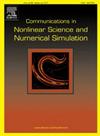Information dissemination and phase transition in fractal social networks
IF 3.4
2区 数学
Q1 MATHEMATICS, APPLIED
Communications in Nonlinear Science and Numerical Simulation
Pub Date : 2025-04-02
DOI:10.1016/j.cnsns.2025.108812
引用次数: 0
Abstract
Fractals are a common geometric structure in nature, exhibiting the rich complexity and regularity of the physical world. In the study of complex networks, the self-similarity and multi-layered characteristics of fractal networks make them an ideal model for investigating information dissemination mechanisms. This paper constructs a fractal social network with three-layer granularity structure and proposes a novel dynamic fractal propagation model: F-SI model, in order to explore the factors influencing information propagation and the phase transition phenomena in fractal social networks. In the propagation model, node interest and node contribution are introduced to measure the cumulative impact and propagation probability of nodes in networks of different granularities, and to explore the dynamics of information dissemination under different conditions. The experiments show that information dissemination in fractal social networks exhibits the staircase propagation and phase transition phenomenon. The phase transition is closely related to the group structure and infection density of networks with varying granularities. Research indicates that controlling the propagation speed is more effective in curbing information dissemination in fractal network than controlling the propagation scope. This study provides theoretical guidance for controlling the spread of epidemics and public opinion in networks.
分形社会网络中的信息传播与相变
分形是自然界常见的几何结构,表现了物理世界丰富的复杂性和规律性。在复杂网络研究中,分形网络的自相似性和多层特性使其成为研究信息传播机制的理想模型。本文构建了一个三层粒度结构的分形社会网络,并提出了一种新的动态分形传播模型:F-SI模型,以探讨分形社会网络中信息传播的影响因素和相变现象。在传播模型中,引入节点兴趣和节点贡献来衡量不同粒度网络中节点的累积影响和传播概率,探索不同条件下信息传播的动态规律。实验表明,分形社会网络中的信息传播呈现阶梯传播和相变现象。相变与不同粒度网络的群结构和感染密度密切相关。研究表明,控制传播速度比控制传播范围更能有效地抑制分形网络中的信息传播。本研究为控制网络中流行病和舆论的传播提供了理论指导。
本文章由计算机程序翻译,如有差异,请以英文原文为准。
求助全文
约1分钟内获得全文
求助全文
来源期刊

Communications in Nonlinear Science and Numerical Simulation
MATHEMATICS, APPLIED-MATHEMATICS, INTERDISCIPLINARY APPLICATIONS
CiteScore
6.80
自引率
7.70%
发文量
378
审稿时长
78 days
期刊介绍:
The journal publishes original research findings on experimental observation, mathematical modeling, theoretical analysis and numerical simulation, for more accurate description, better prediction or novel application, of nonlinear phenomena in science and engineering. It offers a venue for researchers to make rapid exchange of ideas and techniques in nonlinear science and complexity.
The submission of manuscripts with cross-disciplinary approaches in nonlinear science and complexity is particularly encouraged.
Topics of interest:
Nonlinear differential or delay equations, Lie group analysis and asymptotic methods, Discontinuous systems, Fractals, Fractional calculus and dynamics, Nonlinear effects in quantum mechanics, Nonlinear stochastic processes, Experimental nonlinear science, Time-series and signal analysis, Computational methods and simulations in nonlinear science and engineering, Control of dynamical systems, Synchronization, Lyapunov analysis, High-dimensional chaos and turbulence, Chaos in Hamiltonian systems, Integrable systems and solitons, Collective behavior in many-body systems, Biological physics and networks, Nonlinear mechanical systems, Complex systems and complexity.
No length limitation for contributions is set, but only concisely written manuscripts are published. Brief papers are published on the basis of Rapid Communications. Discussions of previously published papers are welcome.
 求助内容:
求助内容: 应助结果提醒方式:
应助结果提醒方式:


